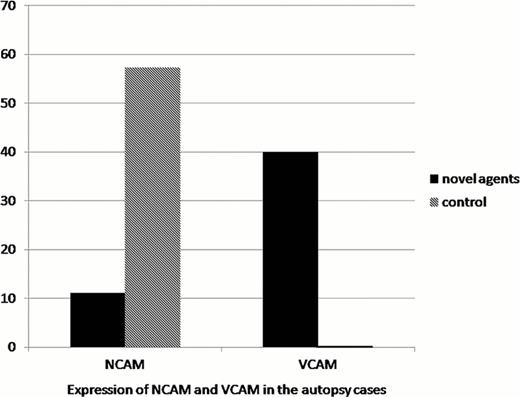Abstract
Abstract 1832
Recent development of novel agents such as bortezomib, lenalidomide, and thalidomide improved the remission rate and survival of multiple myeloma. However, the end stage of myeloma is still uncontrollable. The extramedullary disease (EMD) progression of myeloma was frequently observed in heavily treated patients, whereas few data exist about its incidence and predictive factors. It is well known that adhesion molecules play a role in disease progression and drug resistance. We investigated factors associated with the EMD progression based on the autopsy cases. In addition, the effect of the exposure to novel agents on the expression of adhesion molecules on myeloma cells was analyzed.
We reviewed autopsy reports and medical records of 91 multiple myeloma cases between 1979 and 2012 at the National Medical Center for Global Health and Medicine in Tokyo, Japan. The sites of myeloma cell invasion, infection, hemorrhage and renal complications were studied gross and microscopically. Patient profile, duration of illness, type of monoclonal gammopathy, clinical stage and history of treatment were studied. Durie & Salmon's criteria was used for diagnosis and staging. Factors associated with EMD were statistically analyzed using Student's t-test and the chi-square test. NCAM, VCAM, ICAM, and LFA-1 immunostaining in the bone marrow was performed.
In 91 autopsy cases, 62.6% was male. Mean age and the duration of illness was 63.0 (38–85) years old and 40.6 months (1–156). Eighteen patients (19.8%), 23 (25.3%), and 15 (16.4%) were treated with novel agents, SCT and both respectively. EMD progression of myeloma cells was observed in 65 patients (71.4%). Frequent sites of EMD were spleen (48.9%), liver (37.8%), kidney (31.1%), lymph nodes (28.6%), lung (25.6%), pancreas (20.0%), and gastro-intestinal tract (18.9%).
The incidence of EMD was significantly higher in patients treated with novel agents than in patients without novel agents (94.4% vs. 65.8%, p=0.016). The risk factors of EMD were novel agents, longer duration of illness, and adverse cytogenetic abnormalities.
In the cases with novel agents, the expression of NCAM was significantly low (11.1% vs. 57.4%, p=0.049) compared to the cases without novel agents. However, the expression of VCAM was significantly higher in the cases with novel agents than the cases without novel agents (40.0% vs. 0%, p=0.01).
Multi-organ involvement of myeloma is not rare in autopsy cases of the disease. Exposure to novel agents may contribute to extramedullary spread of myeloma cells and altered expression of adhesion molecules. Further study on other adhesion molecules is needed.
No relevant conflicts of interest to declare.
Author notes
Asterisk with author names denotes non-ASH members.


